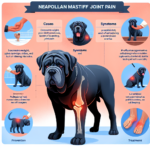Rafeiro do Alentejo Joint Pain: Causes, Symptoms, Prevention, and Treatment

Introduction
The Rafeiro do Alentejo, also known as the Alentejo Mastiff, is a large and robust breed originating from the Alentejo region of Portugal. Historically, these dogs were bred to guard livestock, particularly sheep and cattle, from predators. Known for their loyalty, protective nature, and calm demeanor, Rafeiro do Alentejo dogs are well-regarded for their ability to work independently and make decisions in the field. Their imposing size and strength are notable features, with males typically weighing between 110 to 132 pounds and females slightly less.
Like many large breeds, the Rafeiro do Alentejo is prone to certain health issues, with joint pain being a significant concern. Joint health is crucial for this breed due to their size and the physical demands of their traditional roles. Ensuring the well-being of their joints can help maintain their quality of life and prolong their active years.
Breed-Specific Joint Pain Risks
Genetic Predisposition
The Rafeiro do Alentejo is genetically predisposed to several joint-related issues, including hip dysplasia, elbow dysplasia, and arthritis. Hip dysplasia is a common condition in large breeds where the hip joint does not fit properly into the hip socket, leading to pain and mobility issues. Elbow dysplasia, another hereditary condition, involves abnormal development of the elbow joint, causing lameness and discomfort. Arthritis, a degenerative joint disease, can also affect this breed, particularly as they age.
Age-Related Risks
As the Rafeiro do Alentejo ages, the risk of developing joint pain increases. Typically, signs of joint issues may start to appear in middle age, around 5 to 7 years old. However, some dogs may show symptoms earlier, especially if they have a genetic predisposition. It’s essential for owners to monitor their dogs closely as they age and be vigilant for any signs of joint discomfort.
Activity Level and Joint Stress
The Rafeiro do Alentejo is a working breed with a high activity level, which can contribute to joint stress. Their traditional role as livestock guardians involves a lot of movement, including running and patrolling large areas. While regular exercise is beneficial, excessive or high-impact activities can exacerbate joint issues. Owners should balance their dog’s need for activity with the potential risk of joint stress.
Common Symptoms of Joint Pain in Rafeiro do Alentejo
General Symptoms
- Limping or favoring one leg
- Stiffness, especially after rest or sleep
- Reluctance to move, jump, or climb stairs
- Decreased activity or playfulness
- Swelling around the joints
- Visible discomfort or pain when touched
Breed-Specific Symptoms
In the Rafeiro do Alentejo, joint pain may manifest as a reluctance to perform their guarding duties, such as patrolling or responding to potential threats. Owners may also notice a change in their dog’s gait, with a more pronounced limp or stiffness. Given their stoic nature, these dogs might not show obvious signs of pain, making it crucial for owners to be observant of subtle changes in behavior and movement.
When to Consult a Vet
If any of the above symptoms are observed, it is essential to consult a veterinarian promptly. Early intervention can help manage the condition more effectively and prevent further deterioration. Regular veterinary check-ups are also recommended to monitor the dog’s joint health and catch any issues early.
Preventive Measures for Joint Health
Exercise Recommendations
For the Rafeiro do Alentejo, moderate and consistent exercise is key to maintaining joint health. Activities such as walking, swimming, and controlled play are beneficial. Avoid high-impact exercises like jumping or running on hard surfaces, which can exacerbate joint stress. Regular, low-impact exercise helps maintain muscle strength and joint flexibility without overburdening the joints.
Dietary Suggestions
A balanced diet rich in essential nutrients is crucial for joint health. Foods containing glucosamine and chondroitin can support joint cartilage. Omega-3 fatty acids, found in fish oil, have anti-inflammatory properties that can help reduce joint pain. Consult with a veterinarian to determine the best diet and supplements for your Rafeiro do Alentejo.
Weight Management
Maintaining a healthy weight is vital for reducing joint stress. Excess weight can put additional pressure on the joints, exacerbating pain and discomfort. Owners should monitor their dog’s weight and adjust their diet and exercise routine as needed to keep them within a healthy weight range. Regular weigh-ins and body condition assessments can help ensure the dog remains at an optimal weight.
Early Screening and Monitoring
Early screening for joint issues can help catch problems before they become severe. Regular veterinary check-ups should include joint assessments, particularly for breeds like the Rafeiro do Alentejo that are prone to joint issues. X-rays and other diagnostic tools can help identify early signs of hip or elbow dysplasia, allowing for timely intervention.
Treatment Options for Joint Pain
Non-Surgical Treatments
Non-surgical treatments for joint pain in the Rafeiro do Alentejo include medications, physical therapy, and lifestyle adjustments. Anti-inflammatory drugs and pain relievers can help manage symptoms. Physical therapy, including exercises and massage, can improve joint mobility and reduce pain. Lifestyle adjustments, such as providing a comfortable bed and avoiding stairs, can also alleviate discomfort.
Surgical Options
In severe cases, surgical intervention may be necessary. Common surgeries for joint issues include hip replacement, elbow arthroscopy, and joint fusion. These procedures can significantly improve the dog’s quality of life by reducing pain and restoring mobility. However, surgery should be considered a last resort after exploring all non-surgical options.
Alternative Therapies
Alternative therapies such as acupuncture, hydrotherapy, and massage can also benefit dogs with joint pain. Acupuncture can help reduce pain and inflammation, while hydrotherapy provides low-impact exercise that strengthens muscles without stressing the joints. Regular massage can improve circulation and reduce muscle tension around the affected joints.
Lifestyle and Management Tips
Daily Care Routine
A daily care routine for a Rafeiro do Alentejo with joint pain should include gentle exercise, a balanced diet, and regular monitoring of their condition. Short, frequent walks and low-impact activities like swimming can help maintain joint health. Providing a comfortable, supportive bed and avoiding stairs can also make a significant difference in their comfort.
Modifying the Home Environment
Making the home environment more comfortable for a dog with joint pain involves several modifications. Ramps can replace stairs to reduce strain on the joints. Orthopedic beds provide better support and cushioning. Non-slip mats can prevent falls on slippery surfaces. Ensuring easy access to food, water, and favorite resting spots can also help.
Long-Term Management
Long-term management of joint pain involves regular veterinary check-ups, consistent exercise, and a balanced diet. Monitoring the dog’s weight and adjusting their care routine as needed can help manage their condition effectively. Owners should also stay informed about new treatments and therapies that may benefit their dog.
FAQs About Rafeiro do Alentejo and Joint Pain
What are the early signs of joint pain in Rafeiro do Alentejo?
Early signs include limping, stiffness, reluctance to move, and decreased activity. Subtle changes in behavior, such as avoiding stairs or hesitating to jump, can also indicate joint pain.
Can joint pain in Rafeiro do Alentejo be prevented?
While genetic predisposition cannot be changed, preventive measures like regular exercise, a balanced diet, weight management, and early screening can help reduce the risk and severity of joint pain.
What is the best diet for a Rafeiro do Alentejo with joint pain?
A diet rich in glucosamine, chondroitin, and omega-3 fatty acids can support joint health. Consult with a veterinarian to determine the best diet and supplements for your dog.
Are there any specific exercises that are beneficial for joint health?
Low-impact exercises like walking and swimming are beneficial. Avoid high-impact activities that can stress the joints. Consistent, moderate exercise helps maintain muscle strength and joint flexibility.
When should I consider surgery for my dog’s joint pain?
Surgery should be considered when non-surgical treatments are no longer effective, and the dog’s quality of life is significantly affected. Consult with a veterinarian to discuss the best options for your dog.
Conclusion
Joint pain is a significant concern for the Rafeiro do Alentejo, given their size and activity level. Understanding the causes, symptoms, and preventive measures can help owners manage their dog’s joint health effectively. Regular veterinary check-ups, a balanced diet, consistent exercise, and weight management are crucial for maintaining joint health. Early intervention and appropriate treatment can significantly improve the quality of life for dogs suffering from joint pain. By taking proactive steps, owners can ensure their Rafeiro do Alentejo remains active and happy for many years.




